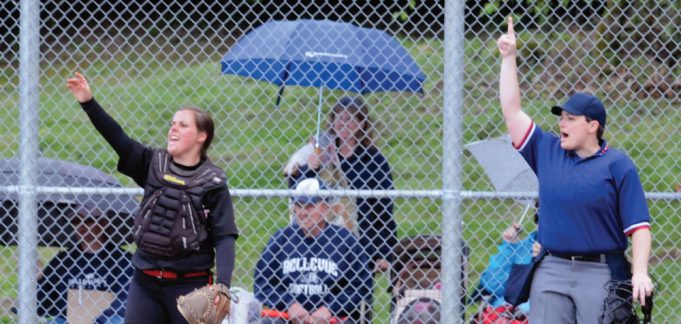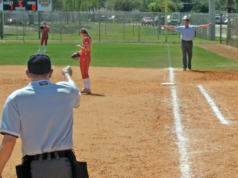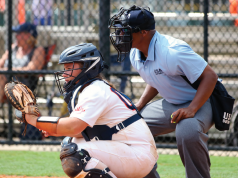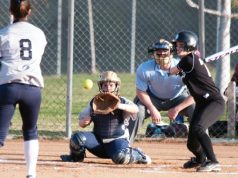There are two rules that often give umpires pause during a game — infield fly and intentional drops. The rules regarding each are relatively simple, but a lot can happen to muddy the waters. The following is a breakdown of the two rules and how they can impact the game.
Infield Fly
The infield fly rule is in effect only when there are less than two outs with either runners on first and second base or bases loaded. The intent of this rule is to prohibit the defense from getting multiple outs by dropping the ball and forcing out the runners on base, who are pinned near their bases while the ball is in the air.
By rule, an infield fly cannot be called on a line drive or attempted bunt. It should be called on a high fly in the infield or to the outfield but near enough to the infield to satisfy the intent of this rule, whether it is an infielder or outfielder who eventually makes the catch. The fielder must be able to catch the fly ball with ordinary effort — when an infielder (or outfielder as appropriate) can nearly settle under the ball while facing home plate; if an infielder could have caught the ball with normal effort and an outfielder calls her off and takes the catch, it is still an infield fly.
Other important parts of the infield fly rule:
- Any defensive player who positions herself in the infield at the start of the pitch shall be considered an infielder.
- If a declared infield fly becomes a foul ball, it is treated the same as a foul ball.
- If the ball falls untouched to the ground in foul territory and rolls into fair territory before passing first or third base, it is an infield fly.
• Failure of players and coaches to hear the call shall not void the call.
If interference occurs during the flight of a potential infield fly, the ball is immediately dead and the umpire shall judge if the ball is in fair or foul territory — if fair, the batter is out and if foul, infield fly does not apply, the batter is returned to the batter’s box and a foul ball is assessed to her count if less than two outs. In any case, the violator is out and runners are returned to the bases occupied at the time of the pitch.
The only big difference between the codes for infield fly is:
For all codes except NCAA, the situation dictates an infield fly rule is in effect whether or not the umpires call it. In NCAA, if it is not declared by an umpire, it is not in effect (A.R. 11-23).
Most of the time the infield fly rule is invoked, it is a relatively easy call. The pop-up is usually high enough for a fielder to settle under it and make the catch (at lower levels use discretion as to what “ordinary effort” might encompass), runners will stay near their bases, and no other play develops. The plate umpire declares the batter-runner out, and since the ball is caught there is no argument or discussion. But chaos may reign if the ball is dropped by the fielder or drops to the ground untouched.
All umpires on the field must recognize that the batter-runner is declared out as soon as the infield fly rule is invoked, and all forces are removed. The call cannot be changed unless the rule is applied incorrectly, in which case:
If the ball is caught, most likely there are no consequences. Batter is out and runners are still on their original bases.
If the ball is not caught, the batter-runner will probably have reached first base and should remain there.
If any other runners are affected they should be placed on the base they would have reached safely or, more likely, declared out if the incorrect ruling did not affect an out on the runner; that is, she would have been out regardless of the incorrect ruling.
Mechanics
Umpires should use the umpire-to-umpire signal when the infield fly situation is in effect and repeat it for each batter who comes up when the situation dictates — right hand to left chest (NCAA — open palm). When it is no longer in effect:
NCAA and USSSA — use the right hand in a wiping motion on the left forearm; NFHS and USA Softball — tap your left forearm with the right hand.
When making the call, fully extend the right arm above the head and either point the index finger up (NCAA) or clench the fist (all other codes) while verbalizing, “Infield fly. The batter is out.” The call must be loud enough for the infielders, runners and base coaches to hear it. If the ball is near the foul line, the umpire shall declare, “Infield fly, the batter is out if fair.” After completion of the catch or a ruling of a fair ball, verbalize, “The batter is out,” and signal an out.
The infield fly call should not be made until the ball has reached its highest point. The judgment should be made when the situation satisfies the intent of the rule — if the fielder could let the ball drop and be able to get multiple outs on the play, call it.
Intentional Drop
The intentional drop rule is not often invoked during a game, but we must be ready to call it when appropriate — less than two outs and a runner is occupying first base at the time of the pitch, regardless of where other runners may be. There are differences with this rule among the codes.
The NCAA rule (11.17) and the USA Softball rule (Rules Supplement 30) clearly state the ball must be legally and actually caught, and then deliberately dropped. A ball that is trapped or guided to the ground is not considered as having been intentionally dropped.
For NFHS (8-2-10, 8.2.10B) and USSSA (8-16f), manipulating the ball to the ground in any way causes an intentional drop. For all codes, the batter is not out if the infielder permits the ball in flight to drop untouched to the ground.
For all codes, when this rule is invoked, the ball is immediately dead, the batter is declared out and each baserunner must return to the base legally occupied at the time of the pitch. If the runner configuration also puts the infield fly rule into effect, the infield fly rule takes precedence over an intentionally dropped ball. Ignore the dropped-ball effect and apply only the infield-fly-rule effect.
What's Your Call? Leave a Comment:
Note: This article is archival in nature. Rules, interpretations, mechanics, philosophies and other information may or may not be correct for the current year.
This article is the copyright of ©Referee Enterprises, Inc., and may not be republished in whole or in part online, in print or in any capacity without expressed written permission from Referee. The article is made available for educational use by individuals.



















